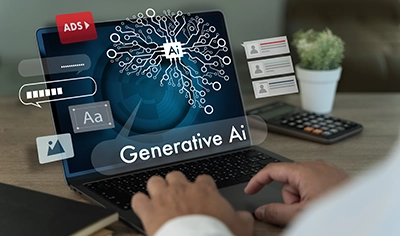Model Context Protocol (MCP) marks a transformative shift in the field of artificial intelligence. Traditional AI systems work in isolation, cut off from the real-world data they need to deliver maximum value. MCP closes the gap by connecting AI systems directly to multiple data sources without complex integration headaches.
The protocol tackles persistent challenges that frustrated early AI adopters. It fixes the notorious problem of context loss during complex tasks and security risks that made many hesitant to fully embrace AI. With MCP, companies are discovering opportunities for automation and customer support that weren’t possible before. These aren’t minor improvements but fundamental changes to how work gets done.
This blog explores how Model Context Protocol drives lasting business success. It also explains what sets MCP apart from conventional approaches and, more importantly, how one can bring these advantages to their business operations.
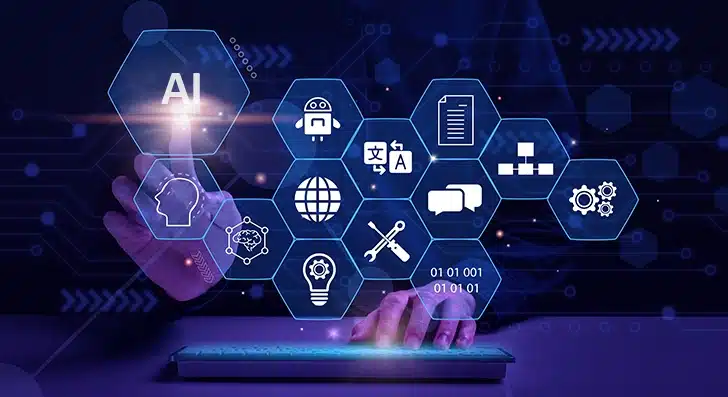
Table of Contents
What is Model Context Protocol (MCP)?
How MCP Differs from Traditional AI Integrations
The Role of MCP in Enabling Contextual Data Integration
Key AI Challenges Solved by MCP
- 1. Limited Access to Real-Time Data
- 2. Context Loss in Multi-Step Workflows
- 3. Security and Permission Management
Core Capabilities That Drive Strategic Advantage
- Real-Time Data Access and Retrieval
- Multi-System Orchestration
- Persistent Memory and State Management
- Feedback Loops for Continuous Improvement
Real-World Use Cases of MCP AI in Business
What is Model Context Protocol (MCP)?
The Model Context Protocol (MCP) is an open standard that changes how AI systems connect with external data sources and tools. It creates a universal framework that connects AI systems with the information they need to function properly.
MCP works like a universal USB-C port for AI applications. It provides a standard way to connect AI models to data sources and tools of all types without custom coding for each connection. This standardization isn’t just a minor technical improvement—it fundamentally changes how AI systems access and use information.
At its core, MCP in AI follows a straightforward client-server architecture with three main components:
- MCP Clients: Components that maintain one-to-one connections with servers
- MCP Servers: Lightweight programs that expose specific capabilities (e.g., data access, tools) through the protocol interface
- MCP Hosts: Programs like Claude Desktop, IDEs, or other AI tools that need external data
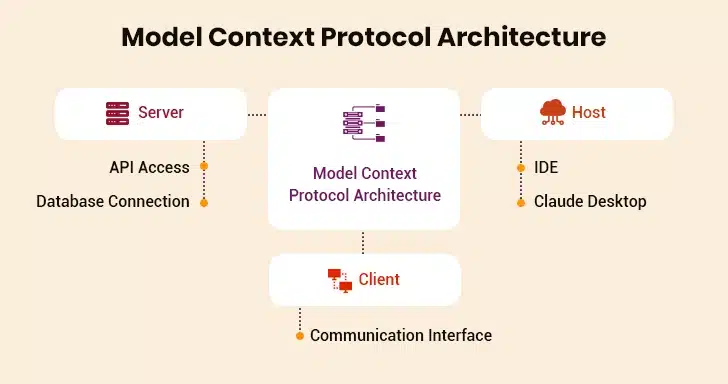
This structure allows AI systems to connect smoothly with both local sources (files, databases) and remote services (external APIs) through a consistent interface.
Optimize Operations with Expert AI Solutions
How MCP Differs from Traditional AI Integrations
Before MCP, connecting AI systems to external tools was highly challenging. This is because custom connections were needed for each data source. So, for ‘X’ different AI applications and ‘Y’ different tools, developers potentially needed to build X*Y integrations. The result? Duplicated effort and inconsistent implementations.
MCP changes this approach entirely. Instead of custom integrations for each AI-tool combination, MCP provides a single, standard protocol. This shrinks the integration problem to an ‘X+Y’ scenario. Here, application developers build X MCP clients (one per AI application), while tool creators build Y MCP servers (one per system).

Traditional integration methods like REST APIs usually:
- Need preset connection points
- Can’t adapt in real time
- Have trouble with complex system interactions
- Need lots of upkeep
With MCP, AI models can find available tools automatically, set up interaction rules in real time, and preserve context across interactions. It also enables real-time bidirectional communication, letting models both retrieve information and trigger actions.
The Role of MCP in Enabling Contextual Data Integration
Even the most sophisticated AI models have struggled with a fundamental limitation: isolation from real-world data. Information silos and legacy systems prevented models from building the context needed for truly intelligent responses. MCP breaks down these barriers. It creates secure, two-way connections between data sources and AI tools.
So, how does MCP in AI make contextual data integration possible?
First, it gives AI models a structured way to retain, update, and access context. They don’t lose track of past interactions or information.
Second, the protocol cuts unnecessary processing by standardizing context management. Rather than forcing models to constantly reinterpret changing data formats or connection methods, MCP presents information in a consistent, optimized format.
Third, MCP secures data access through standardized authentication and permission controls. The protocol now requires the OAuth 2.1 framework for authenticating remote HTTP servers. This ensures secure integration with enterprise systems.
By standardizing these connections, MCP allows AI systems to maintain awareness as they move between different tools and datasets. This replaces the fragmented integration mess with a unified approach that delivers results.
The industry has recognized the value of MCP. Many, including Microsoft, have implemented it in their workflows.
Key AI Challenges Solved by MCP
AI has promised many benefits. However, reality often falls short of hype. Several critical challenges have prevented organizations from getting real value from their AI investments. MCP in AI addresses these issues, paving the path for powerful applications.
1. Limited Access to Real-Time Data
Here’s a painful truth: traditional AI models operate on stale data. Research states that data users waste up to 40% of their time trying to get fresh insights.
An AI system that makes recommendations based on outdated information can provide limited benefits. As Confluent’s Chief Product Officer Shaun Clowes puts it, “At the end of the day, information has a decay rate. So, think about customer feedback. It has a decay rate, or what your competitors are doing has a decay rate. So, any new piece of data decays in its value to your decision-making very, very quickly.”
The old approach of working on static data delivers stale insights. The absence of up-to-date information may also cause AI systems to hallucinate and produce misleading outputs.
MCP fixes this problem. It connects AI directly to source systems, letting models query the most current information before generating responses. The result? AI always works with fresh data without storing unnecessary copies.
2. Context Loss in Multi-Step Workflows
Remember that frustrating experience when a chatbot forgot what you just told it? The same problem plagues complex AI workflows. Traditional models are stateless by nature—they forget previous steps unless users keep conversation history in prompts. This limitation restricts multi-stage problem-solving.
MCP solves this problem through structured memory management. Organizations using MCP can:
- Trace decisions back to their original inputs
- Audit agent behavior across complex processes
- Reduce hallucinations through consistent context
In essence, MCP connects agents, tools, and actions. It creates persistent memory all agents can access, preserves context during task switching, and provides unified logging for transparency. This transforms AI from a mysterious black box into a system one can understand and debug.
3. Security and Permission Management
As AI systems move between different tools, they create security blind spots. In such a scenario, older methods of security and access management (e.g., static access policies or blacklists) no longer work.
MCP in AI fixes the problem with a comprehensive security architecture. The protocol handles authentication properly, prevents unnecessary data access, and connects every request to specific identities and policies. It also maintains end-to-end encryption. Most importantly, it follows a strict no-storage policy: no data is saved in AI systems after they have worked on a query.
Through these capabilities, MCP removes the roadblocks that once prevented organizations from fully embracing artificial intelligence.
Core Capabilities That Drive Strategic Advantage
MCP’s strategic value comes from many of its capabilities that give businesses a strong competitive edge. These capabilities help companies handle their day-to-day operations and build a foundation for new ideas.
I. Real-Time Data Access and Retrieval
Imagine having AI that works with information the moment it appears, not days or weeks later. MCP makes this possible by connecting AI directly to live data sources. This eliminates the lag between when information appears and when it becomes useful. It also solves a fundamental problem in business intelligence: data getting stale fast.
With MCP-powered real-time capabilities, companies can:
- Detect and respond to trends and patterns quickly
- Improve supply chain operations through constant monitoring
- Enable smart pricing and inventory control
In fraud prevention, for example, MCP allows AI to spot unusual transaction patterns as they occur. As a result, suspicious activities get flagged before significant losses happen. This approach improves accuracy and operational efficiency in ways that weren’t possible before.
AI Advantage Ensuring Business Readiness for Tomorrow
II. Multi-System Orchestration
MCP makes various AI components, databases, and tools work together in harmony without constant human supervision. Through MCP, organizations automate complex workflows that span multiple systems, intelligently allocate resources, and handle failures when they occur. These capabilities also create ecosystems where several models are chained together to tackle tasks too complex for any single model.
The best part? This approach drastically cuts both development and maintenance costs. Instead of building custom integrations for every combination of AI tools and data sources, companies create standardized connections that work across their entire technology stack.
III. Persistent Memory and State Management
Model context protocol overcomes a major limitation of traditional AI: forgetting past conversations. MCP in AI creates standardized ways for models to remember context across interactions, whether those interactions happen seconds or days apart.
This persistent memory allows AI to remember who users are and what they’ve previously discussed. This capability fundamentally changes how we interact with artificial intelligence.
What does this mean in practice? AI systems can now manage long-running processes that take weeks. They can also support workflows where humans and AI collaborate. They can also maintain state across different sessions happening days apart.
IV. Feedback Loops for Continuous Improvement
MCP enables continuous learning and improvement of AI systems. The protocol’s feedback loop helps AI get smarter over time by collecting and incorporating the right data for improvements.
Here’s how the cycle works: the system takes in information, processes it using algorithms, produces output, collects feedback on that output, and then uses this feedback to adjust and improve. This creates a virtuous cycle that delivers several business benefits:
- Improved customer satisfaction through prompt addressing of feedback
- Enhanced product quality through leveraging insights from feedback data
- Increased operational efficiency through automated feedback analysis
For instance, AI-powered inspection systems in manufacturing can spot defects in real-time and automatically adjust settings based on what they observe. This helps maintain optimal quality without requiring constant human oversight.
Real-World Use Cases of MCP AI in Business
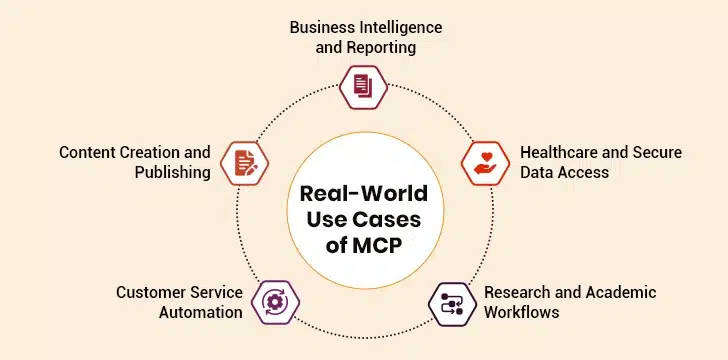
Many organizations have started using the protocol to solve complex business problems. MCP AI proves its worth through applications that deliver measurable business value.
1. Customer Service Automation
Customer service chatbots with MCP capabilities can tap into live customer records—order history, past tickets, or shipping status—all in real-time. So, if a customer asks about their order, the bot immediately understands which orders they are asking for, and their status. It can also offer specific information if required.
The bot can even kick off actions like processing returns or escalating issues without constant human handholding. Unlike traditional bots that get confused when conversations take unexpected turns, MCP-powered systems follow complex interactions with remarkable accuracy.
2. Content Creation and Publishing
Writers and marketing teams find MCP particularly valuable because it connects AI writing assistants to their existing toolkit—grammar checkers, content management systems, and brand guidelines. Need to craft social media posts that follow strict brand voice while pulling in specific product details? MCP makes this possible.
The AI can also format content properly for different platforms and push it live while ensuring everything aligns with established standards. This streamlines the entire creation process from initial draft to final publication. It also maintains quality at each step.
3. Business Intelligence and Reporting
MCP lets AI connect directly to dashboards, spreadsheets, or analytics platforms for immediate insights. Business leaders can quickly analyze sales trends or performance reports. No need to reach out to a business analyst for every kind of information. This capability changes how organizations approach analytical decision-making. MCP creates an intelligent layer that continuously monitors incoming data and alerts teams to important trends or anomalies.
4. Healthcare and Secure Data Access
Healthcare organizations face unique challenges with sensitive patient information. MCP applications allow healthcare workers to securely access electronic health records (EHR) while adhering to privacy regulations.
Doctors using MCP-powered AI systems spend much less time doing paperwork. This frees them to focus on actual patient care instead of administrative tasks. In addition, the protocol’s built-in authentication ensures AI systems only see the data they’re authorized to access. This way, patient information stays protected while workflows become more efficient.
5. Research and Academic Workflows
For researchers drowning in information, MCP offers a lifeline. Researchers can now gather, summarize, and reference information in one place instead of jumping between different databases. Literature reviews that once took weeks can be completed in days as the AI gathers relevant papers, extracts key findings, and formats citations properly.
The system remembers which sources have been reviewed. It can also highlight contradictions or connections across different papers. This creates a unified workspace for complex academic tasks.
Implementing MCP AI for Long-Term Success
Organizations need a systematic approach to deploy the MCP successfully. The implementation goes beyond just setting up the technology. Companies adopting MCP AI should follow specific steps to create lasting value.
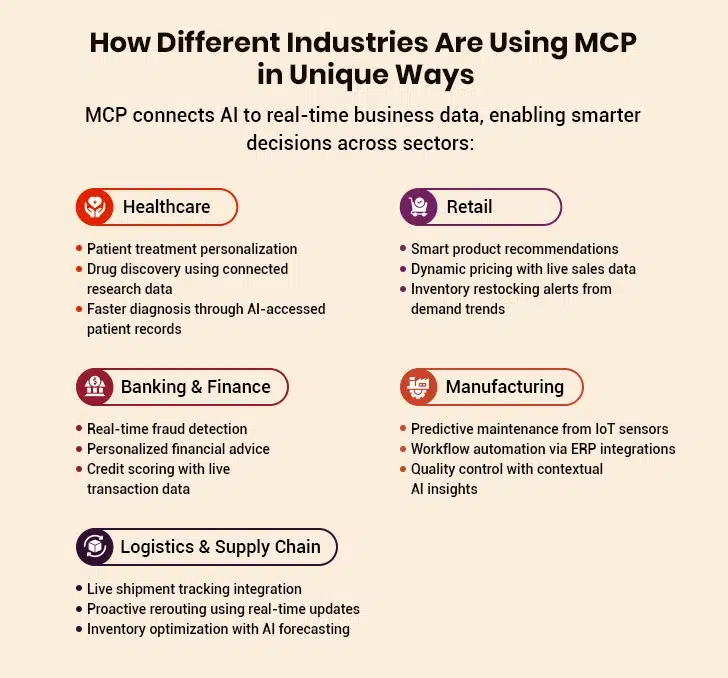
1. Audit Existing AI Infrastructure to Spot Gaps
Effective implementation starts with a detailed assessment. Companies need to thoroughly examine their current AI systems to find integration opportunities. This process reveals where data connections fall short and which systems would gain the most from MCP integration. Industry experts frequently point to organizational immaturity as a major roadblock to effective AI implementation. Beyond just focusing on algorithms, IT teams should evaluate how AI systems are governed and how well they connect to each other.
2. Run Pilot Projects to Test Contextual Adaptability
A majority of AI projects fail because stakeholders aren’t aligned, and data quality falls short. This makes controlled testing of MCP projects essential. Successful pilot phases begin with specific departments or processes where contextual enhancement shows potential. During these pilot phases, teams should:
- Create analytics dashboards that track performance metrics
- Schedule regular reviews with stakeholders to maintain alignment
- Gather and analyze user feedback to fine-tune the implementation
3. Scale and Integrate Across Departments
Once pilot projects prove their value, companies should scale MCP implementation strategically. However, teams often hit productivity walls as project complexity increases. To ensure success, businesses should develop clear frameworks and standards that guide them through implementation. Such a structured approach makes AI projects efficient by allowing better resource allocation and preventing duplicated efforts.
4. Focus on Change Management
The human factor can make or break MCP implementation. Most change initiatives fail because of poor communication and confusing processes. Organizations must develop change management strategies specifically designed for AI adoption.
What matters the most? Clearly explaining why changes are happening. Interestingly, AI tools themselves can help craft communication strategies that address employee concerns and increase buy-in.
Success with MCP isn’t accidental. It requires methodical planning, careful testing, and thoughtful scaling. Above all, it demands attention to the human elements of change because even the most powerful technology delivers value only when people embrace it.
The Strategic Path Forward with MCP
MCP isn’t just another AI advancement. It fundamentally reshapes how businesses deploy and benefit from artificial intelligence. The protocol solves many stubborn problems that held back AI’s potential: data access bottlenecks, unreliable tool interactions, memory limitations, and security vulnerabilities.
The shift to contextually aware AI marks an evolution in business technology. Organizations that master the MCP position themselves for lasting advantage as AI becomes central to daily operations. The protocol doesn’t just boost efficiency today; it builds the foundation for continuous innovation. To ensure success, companies should consider partnering with a trusted AI development company like Damco. Our team of experts carefully assesses your business needs and builds custom protocols that give your AI systems the context to perform with precision today and adaptability tomorrow.




